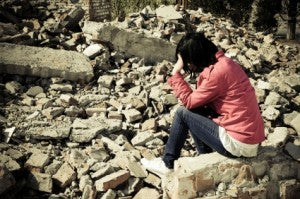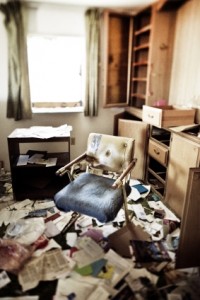
So you’ve survived the earthquake, what do you do now?
First of all, be ready for aftershocks. Stay indoors until the shaking stops and you're sure it's safe to exit. If you go outside after the shaking has stopped, move quickly away from the building to avoid falling debris.
Also be aware of the potential for tsunamis. If you live in a costal area, and the earthquake happened off-shore, consider moving inland to higher ground. Click
here to read more.
After an earthquake has subsided, check yourself for injuries first. You will be able to care for others more effectively if you are not injured—or if your injuries have been treated. If you are severely hurt, stay in place and let someone know you need help by calling out or making as much noise as possible—unless you need to escape immediate danger. Don’t move until someone can help you. If you have a whistle or something you can hit the floor or wall with, use that as your first way to signal for help because over a period of time yelling can cause dehydration.
If you are able to move, be careful and watch for fallen, broken, or unstable objects. Protect yourself from further danger as much as possible. Put on long pants, a long-sleeved shirt, sturdy shoes, and work gloves—they will help protect you against further injury from broken objects.
We suggest keeping squares of colored paper or cloth by your front window and door. These squares can be used to tell first responders your status. Green means you’re ok and that responders can move on to the next house. Yellow means you need help but it’s not life-threatening. A red square indicates that you need immediate assistance.
After you have taken care of yourself, help anyone you can Replace that is injured or trapped. Call 9-1-1 and give first aid when appropriate. Don't try to move seriously injured people unless they are in immediate danger of further injury. If you do call 911, know that it may take a while to get through. Telephone lines are frequently overwhelmed in disaster situations. Only use the telephone to report life-threatening emergencies. Keep the lines clear for emergency calls to get through.
Be on the lookout for fires. Fire is the most common earthquake-related hazard, due to broken gas lines, damaged electrical wires, or sparks being released near flammable materials. Eliminate fire hazards as much as you can.
Look for and extinguish small fires right away. Check for the smell of hot or burning materials, not just the visible signs of a fire. Small fires can start inside your walls where they aren’t visible and quickly spread throughout the building. Fires following the San Francisco earthquake of 1906 lasted three days, creating more damage than the earthquake itself. [Leave this sentence in but also make it a pull-out.] In the 1989 Loma Prieta earthquake, the fires were contained, but were still a concern; 22 structural fires caused additional damage and threatened lives.
AT THE OFFICE
If you are in an office or retail building, the earthquake will probably set off fire alarms and fire sprinklers. You will not be certain whether there is a real threat of fire, but act as if there is one. Most importantly, use the stairs, not the elevator. If you see or smell smoke, drop to the ground, cover your nose and mouth, and continue to your exit by crawling.
AT HOME
Get everyone out if your home is unsafe. Aftershocks following earthquakes can create more instability in buildings damaged by the initial quake. If your home has experienced structural damage, get out before aftershocks happen.
Help neighbors who may require special assistance. Elderly people, those with disabilities, and their caregivers may need additional assistance. Those who have large families may also need additional help in emergency situations.
Seek out emergency information and instructions from your local officials and local radio stations. If the electricity is out, a portable, battery-operated radio may be your main source of information.
Expect aftershocks. Each time you feel one, you should Drop, Cover, and Hold on! Aftershocks frequently occur minutes, days, and even weeks following an earthquake.

AFTER THE AFTERSHOCK, AT HOME
Inspect your home for damage. If you do not feel safe inspecting your home for damage, leave immediately. If you decide to carry out a preliminary inspection, use battery-powered lanterns or flashlights if you need light. Kerosene lanterns, torches, candles, and matches may tip over or ignite flammables inside, especially if the quake has caused gas leaks.
- Watch for loose plaster, drywall, and ceilings that could fall.
- Examine walls, floors, staircases, doors, and windows to make sure that your home is not in danger of collapsing.
- Leave the gas on at the main valve, unless you smell gas or think it's leaking. It may be weeks or—in a worst-case scenario--months before professionals can turn gas back on using the correct procedures. Explosions have caused injury and death when homeowners have improperly turned their gas back on by themselves.
- Check for gas leaks. If you smell gas or hear a blowing or hissing noise, open a window and quickly leave the building. Turn off the gas using the outside main valve if you can, and call the gas company from a neighbor's home. Click here to learn how to turn off your gas.
- Avoid the added hazard of a chemical emergency. Clean up spilled medicines, bleaches, gasoline, or other flammable liquids immediately and carefully.
- Look for electrical system damage. If you see sparks or broken or frayed wires, or if you smell burning insulation, turn off the electricity at the main fuse box or circuit breaker. If you have to step in water to get to the fuse box or circuit breaker, call an electrician first for advice.
- Open closet and cabinet doors cautiously. Contents may have shifted during the shaking of an earthquake and could fall.
- Avoid smoking inside buildings.
- Check for sewage line damage. If you suspect sewage lines are damaged, avoid using the toilets and call a plumber.
- Inspect the entire length of chimneys carefully for damage. Unnoticed damage could lead to fire or injury from falling debris during an aftershock. Cracks in your chimney can lead to a fire years later.
- If water pipes are damaged, contact the water company and avoid using water from the tap. You can get safe water from undamaged water heaters or by melting ice cubes.
OUTSIDE
Watch out for fallen power lines or broken gas lines, and stay out of the damaged areas of your city. Hazards caused by earthquakes are often difficult to see, and you could easily get hurt.
Stay out of damaged buildings. If you are away from home, return only when authorities say it is safe. Damaged buildings can collapse from aftershocks following the initial quake.
AFTER THE AFTERSHOCKS (GETTING HELP)
When the earthquake and aftershocks have subsided, there are a few more things you should do:
- Take pictures of any damage (to the house and its contents) for insurance claims.
- When entering buildings, use extreme caution. Building damage may have occurred where you least expect it. Carefully watch every step you take.
- Watch animals closely. Leash dogs and place them in a fenced yard. Your pets’ behavior may change dramatically after an earthquake. Normally quiet and friendly cats and dogs may become aggressive or defensive.
After an earthquake you’ll likely have a lot of recovery work to do. If you can get connected with neighbors and community organizations before an earthquake hits, your post-disaster recovery will be much easier. Look for your state’s
Great Shake Out Drill. This is a wonderful way to prepare and collaborate with your community. Most importantly, you’ll be able to learn earthquake preparedness that’s tailored for your region.
The Great Utah Shake Out is happing on April 17, 2013. Click
here to learn more and to register. Here’s a link to
upcoming Great Shake Out Drills (including drills in U.S. Territories, Japan, New Zealand, and Southern Italy!)
Remember to practice ‘Drop, Cover, Hold-on’ with your family and loved ones and you’ll be well on your way to earthquake preparedness.
If you missed the other articles in our
Quake, Rattle, and Roll series, click to read about
how to prepare for an earthquake and
what to do during an earthquake.
SOURCES
http://www.fema.gov/earthquake
http://www.redcross.org/prepare/disaster/earthquake
http://www.vibrationdata.com/earthquakes/lomaprieta.htm


